Martin Zweig was an American stock investor, investment adviser, and financial analyst. According to Forbes Magazine, he was renowned for his “eccentric and lavish lifestyle” as well as having had the most expensive residence in the United States at the time, atop The Pierre on Fifth avenue in Manhattan. He was most well known for his 1986 book “Winning on Wall Street“, which is an investment classic, and his “Zweig Forecast” newsletter which, according to Hulbert Financial Digest, was the top market advisory for the 15 year period between 1980 and 1995.
Zweig appeared regularly on PBS television’s Wall $treet Week with Louis Rukeyser, and in 1992 he was voted into the program’s Hall of Fame. It was on that very program that he stated on 16 October 1987 that he was deeply worried and did not like what he saw in the stock market. The 1987 stock market crash precipitated the next trading day. By the way, we make watching past episodes of this program a regular habit to complement our regular book reading schedule since (1) there is a lot to be learnt from past history and (2) you will be absolutely amazed how often the issues of today were also the issues of some period in the past and hotly discussed on the program.
In contrast to his frequent appearances on television in the late 1980’s and early 1990’s, Martin Zweig lived more privately in his later years, and he passed away in February 2013 at the age of 70.
Many people can point back to that one investment/trading book that fundamentally changed their approaches to the stock market and Winning on Wall Street was that book for us almost a decade ago. It is one of the few books we have read many times over. One of the more interesting approaches he described in the book was related to the use of NYSE market breadth in what has become to be popularly known among breadth aficionados as the “Zweig Breadth Thrust” or ZBT. To generate a signal, the 10-day EMA of NYSE Advances divided Advances plus Declines needs to go from below 0.40 to above 0.615 within 10 trading days. The idea is that a sudden swing from really negative breadth to really positive breadth is a sign of initiation of a strong new rally.
According to the book, there had only been fourteen Breadth Thrusts since 1945. The average gain following these fourteen Thrusts was 24.6% in an average time-frame of eleven months. Martin Zweig also points out that most bull markets begin with a Breadth Thrust. During the last 30 years since the book was published, there have only been 4 genuine ZBT’s using NYSE composite breadth data as shown below. All but the 2007 signal provided positive gains 11 months out:
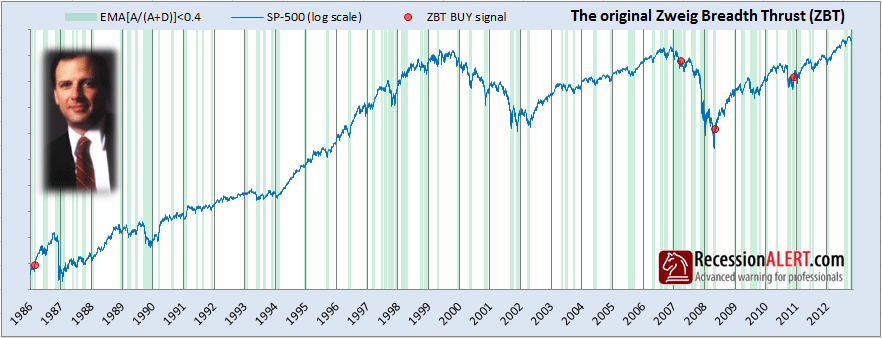
Whilst the rare occurrence of ZBT’s are certainly worth noting, their rarity does not really provide actionable data in the practical sense since during the process of waiting for these signals you can miss out on numerous periods of desirable entry points and subsequent strong, and extended stock market gains. We have found it more practical to impose a stricter lower threshold boundary in conjunction with relaxing the upper-threshold condition as well as the 10-day minimum period within which the “swing” in breadth must occur. We call these the ZBT-A signals which provide four times higher frequency of more actionable high-confidence signals as shown below:
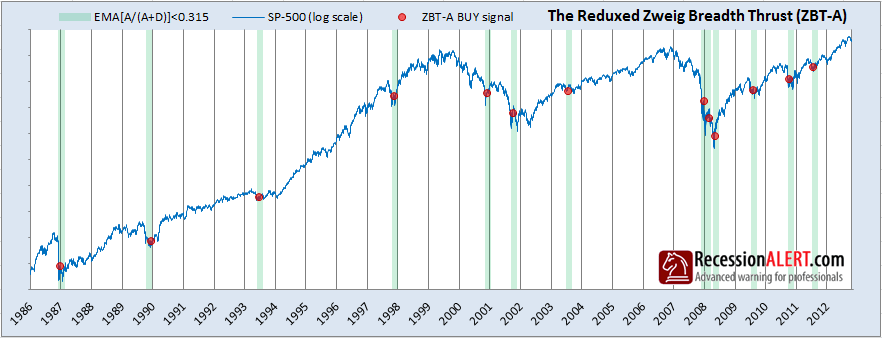
All but 2 of the 13 signals in the above chart provided positive gains averaging 8.4% some 6 month out, which is equivalent to a 84.6% accuracy. If you relaxed the positive outcome holding period from 6 months to 12 months, then only the 2001 signal provided a negative outcome, increasing the accuracy to 92%. In fact, an examination of an actuarial table of the SP-500 gains for various holding periods after each ZBT-A signal yields some more interesting results.
EXTERNAL RE-PUBLISHERS NOTE : BELOW CONTENT IS COPYRIGHTED! SEND YOUR READERS HERE FOR ARTICLE COMPLETION.
The actuarial table below describes the chronological SP-500 gains for various holding periods after each of the thirteen ZBT-A signals shown in the previous historical chart. Signal 13 is the most recent signal which is now showing a 21.02% gain after 12 months, against a 17.25% average expected gain.
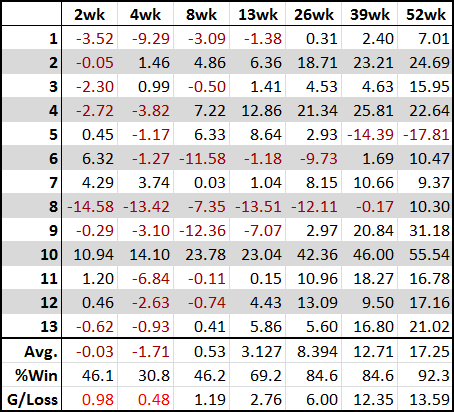
According to the historical record, it appears as if your expectations of a decent return must be pegged at around at least 6 months holding periods, which has an 84.6% probability of a positive outcome, with gains on winning trades outpacing losses on losing trades by 6 times to 1, which is a highly respectable gain/loss (or risk/reward) ratio. Holding for 9 or even 12 months produces subsequently even better results for the risk/reward ratios. We also observe that whilst it is possible for up to 14% gains after 2-4 weeks holding periods, up to 13% losses during these periods is not uncommon either. Given that the ZBT-A buy signals are generated at large, significant bottoms, it is to be expected that extreme volatility at these bottoms on certain occasions will fluctuate short term gains wildly until the markets settle down into the new up-leg.
If one were to retain the original lower threshold requirement of 0.4 for the breadth signal (this is actually a very good lower bound) and just relax the upper bound condition of 0.615, whilst maintaining a 12-day limit during which the “breadth swing” must occur, then we get what we like to call the “Rapid” ZBT-B signal shown below. It provides 6 times as many signals as the ZBT-A’s for a surprisingly small relative reduction in accuracy. This is inclined to provide for much more frequent “buy-on-the-dip” opportunities during bull markets, but with the obvious increase in false signals in the lead up to, and during bear markets. The trick here is to start treating these signal with more suspicion as the Composite Market Health Index starts waning or as recession risks start climbing in the Recession Forecasting Ensemble.
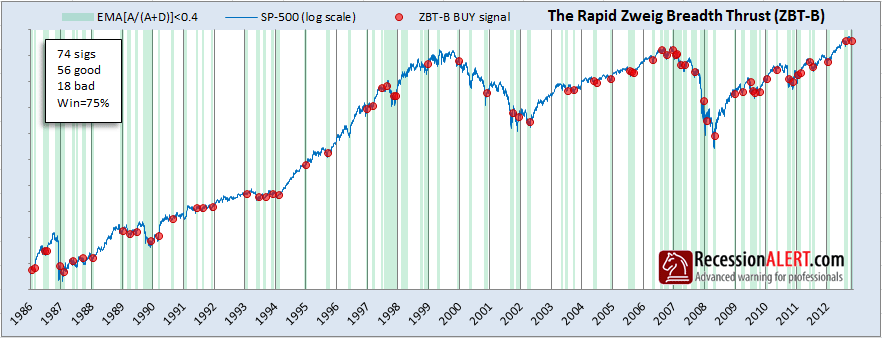
There is a ZWEIG tab available in the live CHARTS menu on our web site where subscribers can track live ZBT, ZBT-A and ZBT-B signals as shown in the Heads-Up display below:
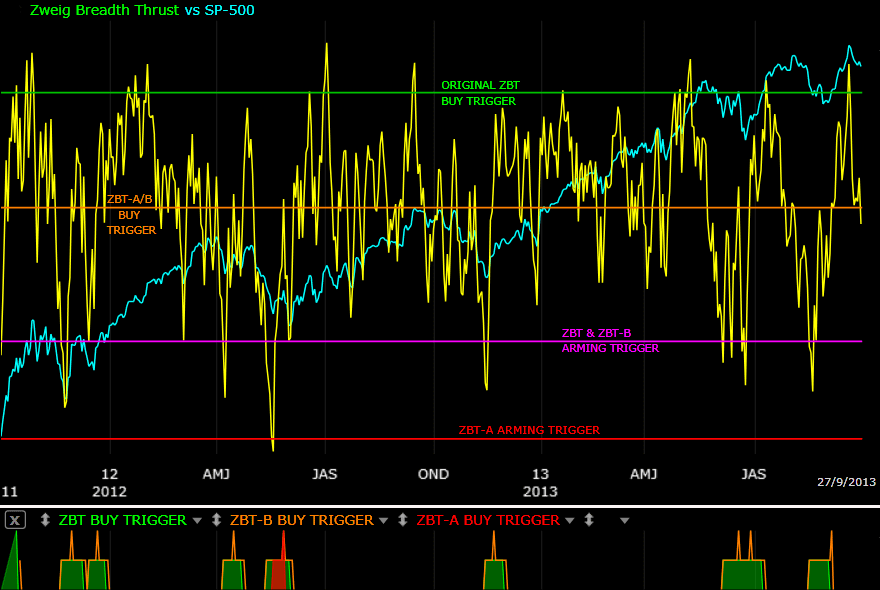
The top panel shows the yellow breadth signal and associated lower/upper thresholds together with the SP-500, whilst the lower “signal panel” shows the development of your opportunity. The signal panel rises by 1 whenever the breadth signal falls below a lower threshold (arming trigger), thus warning you of an opportunity building up. If the yellow breadth signal falls below the red line representing the lower threshold for the ZBT-A trough signal, then the signal line rises and will be shaded red. If the yellow line falls below the purple ZBT or ZBT-B lower threshold the rising signal line will be shaded green.
The signal lines will remain on 1 whilst the minimum time limit (for example 10 days for ZBT and 12 days for ZBT-B signals) is in force. If the yellow breadth signal strikes through the required upper threshold (BUY triggers) whilst the signal line is on 1 then we have met our BUY condition within the minimum time limit and the signal line will spike up further to a value of 2 for the day on which the signal occurred. If the spike is shaded green, we have a traditional, rare, ZBT signal as shown on the extreme left of the chart. If the spike is bordered with orange and shaded black then we have the much more frequent ZBT-B BUY signal. If the spike is shaded red we have the less frequent but very practical ZBT-A “Redux” signal.
The two year chart above displays one ZBT, one ZBT-A and seven ZBT-B signals. All but two ZBT-B signals can be regarded as “immediately profitable” entry points for the market. Not a single signal has led to any losses as shown on the chart, although the 17th April 2012 ZBT-B signal took 3 months to start turning a profit. The most recent signal on the above chart was a ZBT-B on 4th September 2013 which is up 2.4% so far.

Comments are closed.